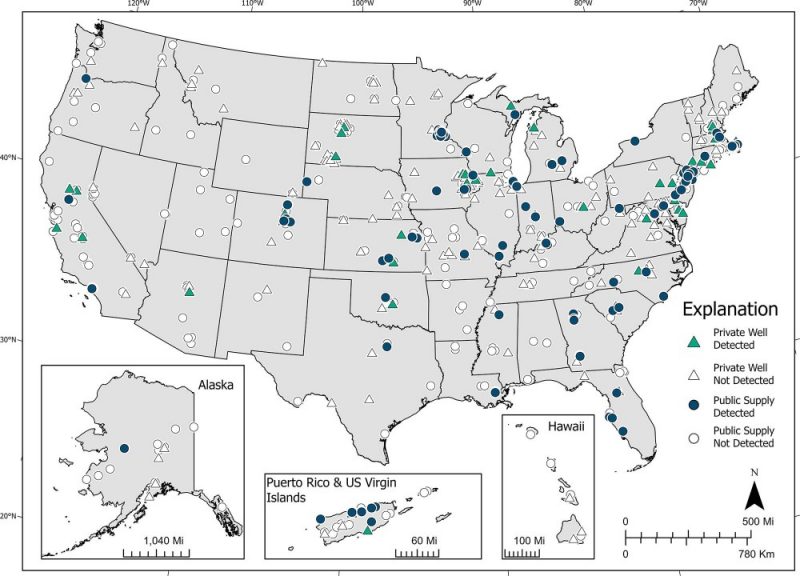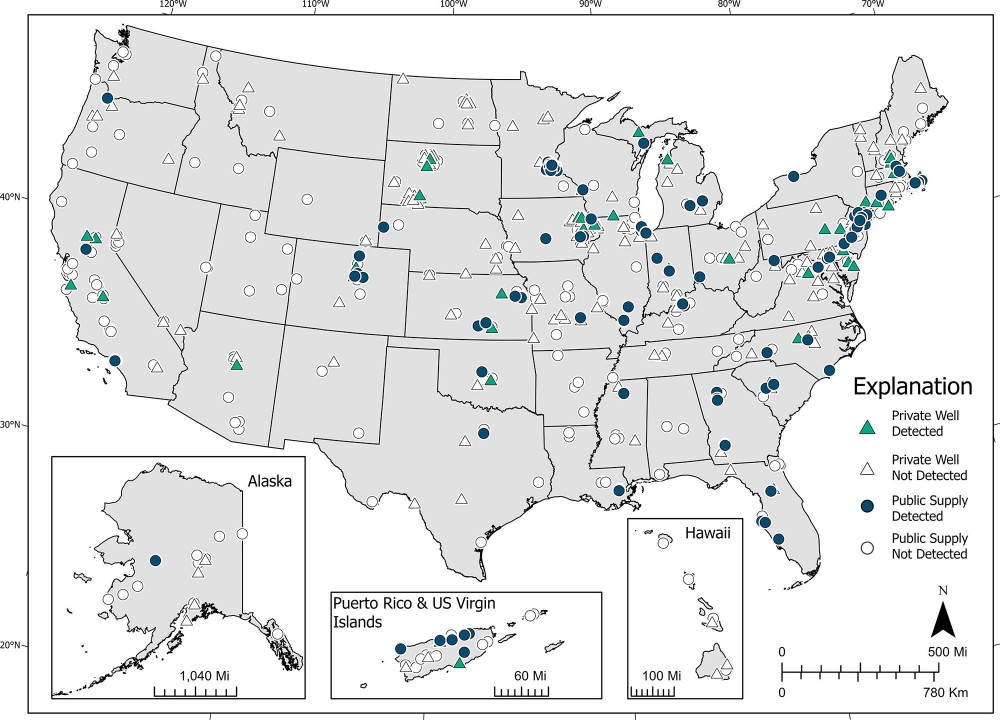2 ways of knowing if there are PFAS in your drinking water

Ever since the US started churning out per- and polyfluoroalkyl substances (PFAS) in the 1940s, these long-lived toxic chemicals have been accumulating everywhere humans have trodden.
Since then, these compounds have leached from industrial facilities and trash systems into our waterways, making our drinking supply one of the main ways forever chemicals are getting into our bodies.
If you’re now eyeing your glass of water suspiciously, know that there are steps you can take to find out if there are PFAS in that H2O, and lower the risk of exposure for you and your family.
Your water might have PFAS
Between 2016 and 2021, the US Geological Survey sampled the water from 716 different taps across the country and found that an estimated 45 percent of tested sites contained at least one kind of forever chemical. The study is the broadest of its kind in the US, making its main finding the best risk estimate we have for PFAS contamination in our drinking water.
While efforts to regulate these chemicals are gaining traction, there is no federal mandate limiting the amount of PFAS in our drinking supply. In March, the Environmental Protection Agency proposed a nationwide enforceable limit of four parts per trillion for each of the six types of PFAS in our drinking water. But while the EPA weighs public comments on the bill, millions of people might still exposed to these persistent pollutants, as not all public water systems in the country are required to monitor and remove them.
Even if the EPA’s proposal succeeds, imposing legal PFAS limits doesn’t necessarily mean our water will be safe to drink. For example, the EPA’s maximum contaminant level goal for perfluorooctanoic acid (PFOA) and perfluorooctane sulfonic acid (PFOS), the most notorious cancer-causing PFAS, is zero.
For these two compounds, “there’s no known safe level,” says Kelly Smalling, a USGS environmental chemist and lead author of the national tap water study.
Researchers are still looking into how forever chemicals impact our health and how to efficiently dispose of them. This is particularly important because there are vast geographical areas in the US where PFAS levels are high enough to pose a health risk over time, but low enough to make it hard to remove them from the environment.
By understanding the risk of PFAS exposure in your drinking water, you can find the best prevention strategy to mitigate it accordingly.
Know thy water source

The easiest step in understanding your risk of PFAS exposure is knowing where you get your water from, says Jamie DeWitt, a pharmacologist at East Carolina University. If it comes from a public supply, you have it easier than those getting their H2O from private wells, as utility companies have to regularly test for contaminants and report the results to the public.
The Environmental Working Group, an advocacy non-profit, has a nifty online tap water database that shows the servicing utility and contaminants detected where you live—just search using your zip code. You can also use this platform to gather information before you talk to your public water provider, which the EPA encourages you to do. If you find high PFAS levels in your water supply, DeWitt recommends you reach out and find out what your utility company is doing to reduce them.
There’s a caveat, though—the data included in the EWG’s database are of contaminants tested by and at the utility plant, which are a few steps removed from the actual amount that you might imbibe at home. A 2022 study published in the journal Environmental Science and Pollution Research, shows that PFAS can leak into the water through the distribution infrastructure, so real PFAS levels might actually be higher than those reported by the EWG. For a more downstream estimate of PFAS contamination, the authors of the USGS study have fashioned an interactive map including data from private wells.
If you live in or near an area where PFAS were detected, there’s a good chance these chemicals are in your tap water, as their footprint tends to spill far and wide. As a proxy for estimating contamination levels in areas where researchers didn’t test directly, the map also includes industry facilities that might be sources for PFAS.
Although the EWG’s tap water database pertains to public utilities only, it could still help the 40 million Americans whose water comes from private wells. Smalling explains this is because neighboring water supplies, whether public or private, usually originate from a common reservoir in the same catchment area. This makes it highly likely that PFAS detected in one source might be present in others nearby.
At-home PFAS tests
There are several PFAS testing kits for household water in the market, where you mail a sample and get results after a week or so.
If you’re thinking about testing your water for PFAS, pick a test kit that follows the EPA’s Method 537.1 and Method 533. The easiest way to know which ones comply with these standards is to follow your state’s recommendations or refer to the EPA’s list of approved manufacturers.
Choosing which test to go with is a delicate balancing act between cost, exposure risk, convenience, and the scope of the test. Lydia Jahl, a science and policy manager at the environmental advocacy nonprofit Green Science Policy Institute, recommends you look for the number of PFAS species a kit can detect (the more the better), and its detection threshold: the lower it is, the more sensitive.
Money can also be an important deciding factor, as these services can cost up to a few hundred dollars. However, the investment might be warranted if you own a well or live near a high-risk zone. For those on a budget, a good alternative is Cyclopure’s PFAS test, which is only $79. While the test meets a slightly older standard and is not government-certified, it does a good job at detecting a whopping 55 types of PFAS and their precursors.
Test kits come with their own instructions, but you’ll find there are general guidelines that apply to most cases:
- Start by thoroughly washing your hands before collection, and make sure you wear a fresh pair of surgical gloves to avoid contaminating the water sample.
- Avoid touching the inside of the collection bottle and its lid. If you must set the lid down, keep the inside facing up.
- For the most accurate measurement, run your faucet on low for at least three minutes to flush the pipes before filling the collection bottle. Do not overfill the container.
- If the sampling bottle contains a preservative, thoroughly mix in the water by carefully inverting the closed container a few times.
- Make sure to have a watch or clock handy, as you’ll need to indicate the location and exact time you collected the sample. If applicable and per the test’s instructions, you can also specify which tap you collected the water from.
- Have some ice ready, as most samples have to be at 43 degrees Fahrenheit when they arrive at the lab. Some tests come with their own ice packs, but depending on the instructions, you may have to make your own with a zip-top bag and some ice cubes.
- Make sure to overnight your specimen or drop it off at a designated site within 24 hours of collection.
Currently, there is no consensus on how often drinking water supplies should be tested for PFAS. For example, the state of New Hampshire recommends testing private wells every three to five years, while Massachusetts only once a decade after an initial negative PFAS result.
You’ve tested your water for PFAS. Now what?
If you are particularly concerned about your risk of exposure, you can take a blood test to learn about your body’s PFAS levels. You can find such tests from manufacturers like EmpowerDX, but they don’t come cheap and they’re likely not covered by insurance, DeWitt says.
Whether your water management company is acting against PFAS or not, an easy way to reduce your exposure to these chemicals is to filter your water supply. You can install filters that clean the water for your entire household at once (point-of-entry filtration), or just that from the specific tap you drink from (point-of-use system).
The market is filled with a wide range of options at varying prices, so choosing a solution for you can be confusing. The EWG has a list with several point-of-use filters, which takes into consideration their ability to remove PFAS, and their associated costs. There are also offerings such as Cyclopure’s $45 filter cartridges, which have been certified by the National Sanitation Foundation.
But any filter is better than nothing, says Jahl, and even traditional, lower-end countertop filters can remove some PFAS from drinking water. She personally opts for the ubiquitous Brita pitcher filter, which relies on activated carbon to filter a broad spectrum of contaminants, including PFAS. To keep the filtration performance in top condition, just remember to switch out your filters as instructed.










